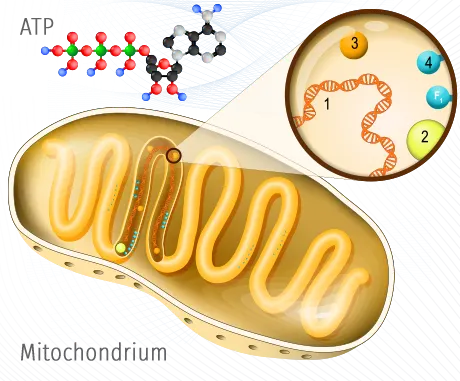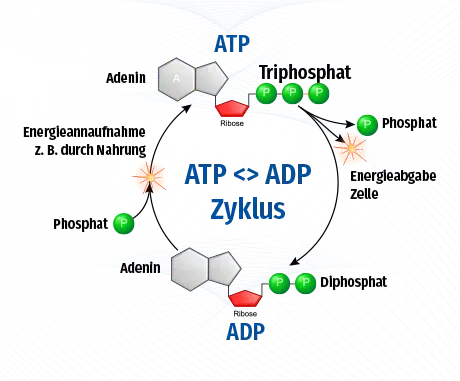
ATP · Adenosine triphosphate, the fuel for our body
The most important chemical energy supply of living beings is adenosine triphosphate, in short ATP. Each individual body cell draws its energy from the ATP. If no ATP is present, the cell eventually dies. Metabolism, cell renewal, digestion, thinking, perception and movement – all those processes would not be possible if there was no ATP. Without ATP, humans are simply not viable.
The fission of an ATP molecule enables all metabolic processes of the body or the cell and is necessary to maintain them permanently. ATP is therefore constantly consumed, which requires a continuous production of ATP. The amazing thing is that the daily turnover of ATP (consumption + regeneration) roughly corresponds to your own body weight.
Production of ATP · Cellular respiration
Cell respiration is a metabolic process in which energy is gained through the degradation of organic substances. In the mitochondria, glucose, oxygen and water are degraded to water and carbon dioxide, resulting in energy in the form of adenosine triphosphate. Therefore, the mitochondria are called the power plants of the cells.
In mitochondria, enzymes split adenosine triphosphate (ATP) into adenosine diphosphate (ADP) and free phosphate, thereby releasing energy. The ADP must then be converted back into ATP, which can only be successfully achieved with an optimal supply of nutrients and perfect cell functions.
Mitochondria are organelles of cellular respiration that synthesize the energy storage and carrier ATP via the respiratory chain and thus produce more than 95% of the cellular energy under aerobic conditions (Scheller et al. 2003).
ATP · Energy
The energy is stored in the chemical bonds of the molecule and is released when a bond is broken up and adenosine diphosphate (ADP) is formed. A muscle cell converts its ATP supply about once per minute. But under stress, a muscle cell consumes about ten million ATP molecules per second.

ATP and the circadian cell clock
The circadian clock and cell metabolism are directly linked because all metabolic processes are under circadian control. A deviation (desynchronization) can lead to health problems, since the energy metabolism can also be impaired with resulting metabolic disorders. Circadian clocks thus interfere with essential metabolic processes and should therefore be considered in the future as a possible cause for the development of metabolic diseases.
The circadian rhythm manifests itself at the molecular level in autoregulatory feedback loops whose activity is regulated by their own proteins. These various control mechanisms allow a precise regulation of the period length of the clock and thus a precise temporal coordination and sequence of the rhythmically controlled processes in the body. While in some translucent organisms the circadian cell clocks are synchronized directly by light, in humans this happens via hormones, proteins and genes. Altogether, 8-10% of the genes of a cell show a circadian rhythm in expression. In the case of proteins, 20% were found to be under circadian control, partly in important metabolic pathways such as carbohydrate metabolism, cell respiration and division, urea cycle and detoxification.
Numerous processes in the human body are regulated by circadian clocks. If the circadian rhythms are disturbed, it can lead to considerable health impairments. The most important intracellular clock is the rhythmic synthesis of ATP in body cells.

